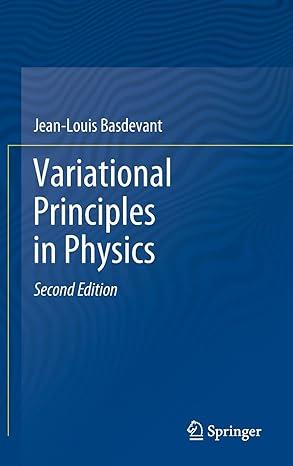Consider the metric [ d s^{2}=frac{R^{2}}{ho^{2}+R^{2}} d ho^{2}+ho^{2} d theta^{2}+ho^{2} sin ^{2} theta d phi^{2} ] where
Question:
Consider the metric
\[
d s^{2}=\frac{R^{2}}{ho^{2}+R^{2}} d ho^{2}+ho^{2} d \theta^{2}+ho^{2} \sin ^{2} \theta d \phi^{2}
\]
where \(R\) is a positive characteristic length.
Notice that one considers this metric as deriving from a "Lorentzian" metric, if one changes the sign of \(R\)
\[
d s^{2}=d x^{2}+d y^{2}+d z^{2}-d w^{2}
\]
by the three-dimensional reduction
\[
w^{2}=x^{2}+y^{2}+z^{2}+R^{2}=ho^{2}+R^{2} \text {. }
\]
The calculation is very similar to that of Example 2.
In spherical coordinates, the Lagrangian of the problem is
\[
\mathcal{L}=\frac{m}{2}\left(\dot{ho}^{2}\left(\frac{R^{2}}{ho^{2}+R^{2}}ight)+ho^{2} \dot{\theta}^{2}+ho^{2} \sin ^{2} \theta \dot{\phi}^{2}ight) .
\]
The conservation laws are the same as before.
1. Rotation invariance yields the conservation of angular momentum. The motion is planar.
2. Choosing the direction of the angular momentum as the polar axis, we have \(\theta=\pi / 2\) and \(\dot{\theta}=0\).
3. The Lagrangian of the planar motion reduces to
\[
\mathcal{L}=\frac{m}{2}\left(\dot{ho}^{2}\left(\frac{R^{2}}{ho^{2}+R^{2}}ight)+ho^{2} \dot{\phi}^{2}ight)
\]
4. The conservation of angular momentum leads to
\[
\frac{d}{d t}\left(ho^{2} \dot{\phi}ight)=0 \quad \Longrightarrow \dot{\phi}=\frac{A}{ho^{2}}
\]
where \(A\) is a constant of the motion.
1. Calculate the energy of the system
2. Derive the parameters of the equation of motion, \(ho(t)\) and \(\phi(t)\).
3. How does the distance to the origin behave as \(|t|ightarrow \infty\) ?
4. What are the equations of the geodesics in the \((x, y)\) plane?
Step by Step Answer:






